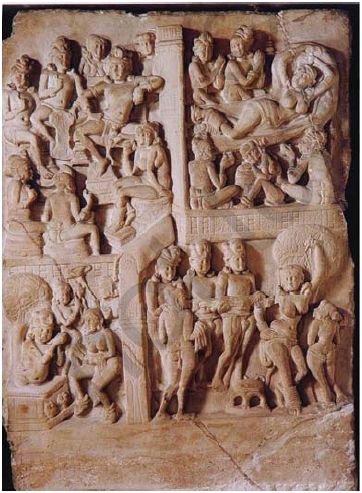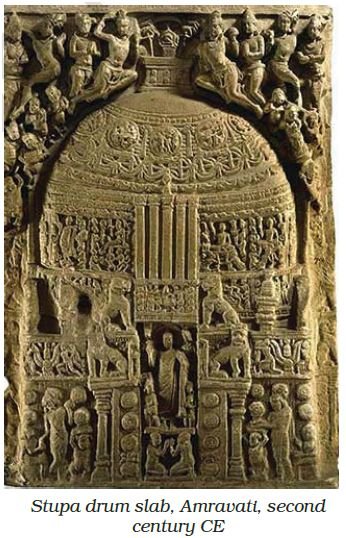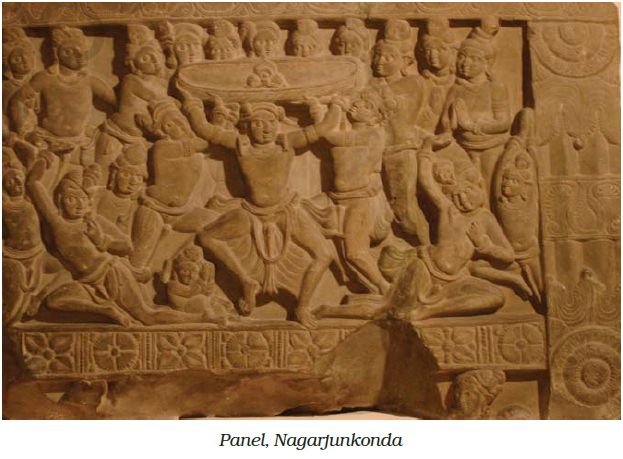Vengi in Andhra Pradesh has many stupa sites likeJagayyapetta, Amaravati, Bhattiprolu, Nagarjunkonda,Goli, etc. Amaravati has a mahachaitya and had manysculptures which are now preserved in Chennai Museum, Amaravati Site Museum, National Museum, New Delhi andthe British Museum, London. Like the Sanchi Stupa, theAmaravati Stupa also has pradakshinapatha enclosed within a vedika on which many narrative sculptures are depicted. The domical stupa structure is covered with reliefstupa sculptural slabs which is a unique feature. The torana of the Amaravati Stupa has disappeared over a period of time. Events from the life of the Buddha and the Jatakastories are depicted. Though in the Amaravati Stupa thereis evidence of construction activity in the third century BCE, it was best developed in the first and second centuries CE. Like Sanchi, the early phase is devoid of Buddha imagesbut during the later phase, in the second and thirdc enturies CE, the Buddha images are carved on the drum slabs and at many other places. Interior space in the composition is created by different postures of the figures such as semi-back, back, profile, frontal, semi-frontal,side, etc.
Sculptural form in this area is characterised by intense emotions. Figures are slender, have a lot of movement, bodies are shown with three bents (i.e. tribhanga), and the sculptural composition is more complex than at Sanchi.Linearity becomes flexible, dynamic movement breaks the staticness of form. The idea of creating three-dimensional space in the relief sculpture is devised by using pronounced volume, angular bodies and absolute attention has been paid to the clarity of formdespite its size and role in the narrative. Narratives are profusely depicted which include events from the life ofthe Buddha and the Jataka stories. There are a number ofJataka scenes that have not been completely identified. Inthe depiction of the birth event, the queen is shown reclining on a bed surrounded by female attendants and asmall-sized elephant is carved on the upper frame of the composition showing the dream of Queen Mayadevi. In another relief, four events related to the birth of the Buddhaare shown. These represent varied ways of depicting the narratives.
The animated movement in the figures gets reduced in the sculptures of Nagarjunkonda and Goli in the thirdcentury CE. Even within the relatively low relief volumethan in the Amaravati sculptures, artists at Nagarjunkonda and Goli managed to create the effect of protruding surfaces of the body which is suggestive in nature and look very integral. Independent Buddha imagesare also found at Amaravati, Nagarjunkonda and ![carve3.JPG]Guntapalle. Guntapalle is a rock-cut cave site near Eluru.Small apsidal and circular chaitya halls have beenexcavated belonging to the second century BCE. The otherimportant site where rock-cut stupas have been excavated is Anakapalle near Vishakhapatanam. In Karnataka,
Sannati is the largest stupa site excavated so far. It alsohas a stupa like the one in Amaravati decorated
Construction of a large number of stupas does not mean that there were no structured temples or viharas or chaityas.We do get evidences but no structured chaitya or vihara survived. Among the important structured viharas, mention may be made of the Sanchi apsidal chaitya structure, i.e.,temple 18, which is a simple shrine temple having front pillars and a hall at the back. Similar structured temples at Guntapalle are also worth mentioning. Along with the
images of the Buddha, other Buddhist images of Boddhisattvas like Avalokiteshvara, Padmapani, Vajrapani, Amitabha, and Maitreya Buddha started getting sculpted.However, with the rise of Vajrayana Buddhism many Boddhisattva images were added as a part of the personified representations of certain virtues or qualities as propagated by the Buddhist religious principles for the welfare of the masses.



Good photographer
Posted using Partiko Android
Thank you
Hi! I am a robot. I just upvoted you! I found similar content that readers might be interested in:
https://abhijeetgautam.wordpress.com/2016/11/08/chapter-7-art-of-post-mauryan-period/